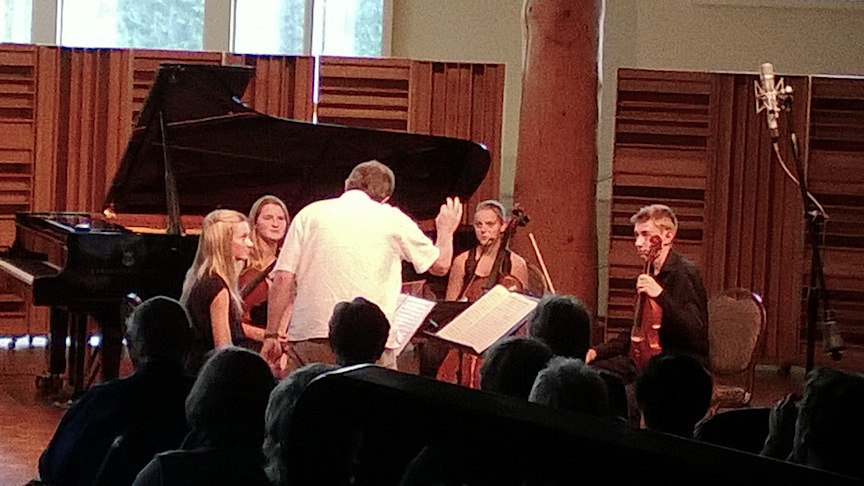
Day 3 at the 11th Banff International String Quartet Competition is all about Joseph Haydn (1732-1809), the composer who brought us the modern string quartet. Everyone in the chamber music world considers his music the ultimate barometer of fine artistry.
- Classical Music 101: What Does A Conductor Do? - June 17, 2019
- Classical Music 101 | What Does Period Instrument Mean? - May 6, 2019
- CLASSICAL MUSIC 101 | What Does It Mean To Be In Tune? - April 23, 2019
The audience at the competition has been growing with every recital. The Eric Harvie Theatre is a 1960s-style fan-shaped all-purpose auditorium that seats 959 people and, by last night, it was more than two-thirds filled.
Haydn’s music requires intense attention to balance, as he was the first composer to write for the two violins, violas and cello as absolute equals. The music is also about dialogue, as the instruments pass around and play with figures and phrases. And Haydn is also about colouring and shading, as well as humour.
The notes themselves are not difficult, but the music is utterly transparent, making every nuance stand out in high relief.
Today, we’ll hear all 10 quartets in three recital rounds, playing nothing but Haydn in front of at least 600 eager listeners each time.
That is how competition’s work, but I couldn’t help thinking of the laugh Haydn might have had if someone had described this scenario to him 250 years ago: One day, hundreds of people will sit for hours in a large, windowless theatre to listen to your music alone, to decide which artists are the best.
Haydn wrote this music to help people pass the time between dinner and bedtime with a few companions. The dialogue in his compositions is a sort of extended metaphor for the witty banter of educated people around a card table, or a few snifters of brandy — relaxed, able to speak freely and enjoying easy company.
Even when Haydn became famous late in life and could be greeted as a star in London, concerts of his music were held in small quarters.
Chamber music.
We moderns consume our chamber music in large halls that separate us from the easy intimacy of dialogue and force musicians to work on a strange caricature of conversation that involves shouting without appearing to shout.
In the artificial reality of a competition or festival, we also consume music in huge chunks — by necessity.
Yesterday, utterly flattened by a performance of Benjamin Britten’s last string quartet, which is a depiction of the mixed emotions he faced as the Grim Reaper stretched out his hand, I had to get away from music for a few minutes and decided to take a walk to the town of Banff, which I imagined to be far, far away.
The Banff Centre is carved out of a hillside overlooking the Bow River valley, surrounded by picturebook peaks. The place is serene — tranquil in a way a Torontonian can never experience, even in the leafy depths of one of the city’s ravines. So I imagined the town as some bucolic mountain oasis, with perhaps a gas station, a post office and a general store.
The reality was thousands of tourists, cars and buses and a main street made up of big-name chain stores interspersed with ice cream shops and souvenir emporia. What really got me was the number of buildings sporting faux-Alpine architecture. Here? Why?
We are all such consumers — of data, of food, of scenery, of music. So much of the time, we don’t commune with the churches, museums and geography in our travels, but try to possess them in some way, through pictures and souvenirs.
I wondered if having too much music in one place at one time isn’t another manifestation of this possessive streak.
As I fled back up the hillside to the sanctuary that is the Banff Centre, I thought about how one can’t separate oneself from the world and still enjoy it. I also thought how amazing it is that Haydn’s genius continues to be loved, treasured and perpetuated despite what the 20th and 21st centuries have done to its context.
Haydn gets the last laugh.
+++
You can follow live streams of today’s three Haydn’s recitals — at 12:30 p.m., 4 p.m. and 9:30 p.m. Eastern — here.
John Terauds
- Classical Music 101: What Does A Conductor Do? - June 17, 2019
- Classical Music 101 | What Does Period Instrument Mean? - May 6, 2019
- CLASSICAL MUSIC 101 | What Does It Mean To Be In Tune? - April 23, 2019



